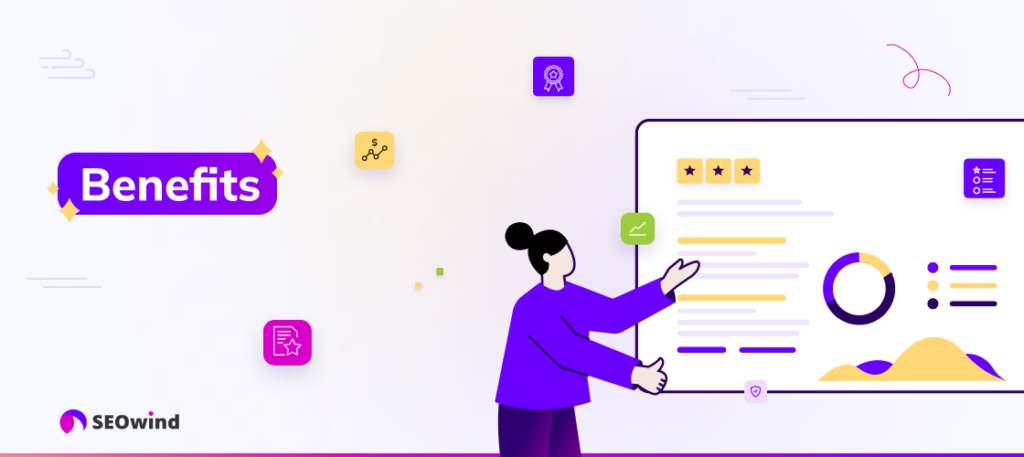As we venture into the digital age, mastering search engine optimization (SEO) is becoming increasingly crucial for businesses and individuals. One of the pillars of a sound SEO strategy is understanding backlinks and their importance.
In this comprehensive guide, I will walk you through all aspects of SEO-related backlinks in 2024. Learn about different types of backlinks, what makes an excellent backlink, how to check any website’s backlinks, strategies to get valuable links pointing to your site, and more! By the end of this article, you will be equipped with indispensable knowledge that can propel your online presence lightyears ahead.
TL;DR
- Backlinks are crucial for SEO, acting as ‘votes’ or recommendations from other websites, helping improve search engine rankings.
- High-quality, relevant backlinks from credible sites are essential for a successful SEO strategy.
- Backlinks can improve rankings, drive organic search traffic, and help search engines find new content.
- There are various types of backlinks, including follow links, nofollow links, sponsored/paid links, user-generated content (UGC) links, editorially placed links, and link schemes.
- Good backlinks should be relevant, and authoritative, generate traffic, have proper placement, and use appropriate anchor text.
- Google Search Console can be used to check and analyze any website’s backlinks.
- To get backlinks, create high-quality content, use HARO or Terkel, write strategic guest posts, publish research, and pitch it to the press.
- Avoid risky backlink sources such as paid links, low-quality directory listings, spammy blog comments, and irrelevant guest posts.
- Examples of backlinks in SEO include blog post citations, news stories, press releases, social media mentions, and resource pages.
- Incoming links (inbound or backlinks) are hyperlinks from other websites directing users to a specific webpage or website, while external links (outbound links) are hyperlinks originating from a specific webpage or website, leading users to a different site. Both types of links contribute to the overall user experience and credibility of a website.
What Are Backlinks in SEO?
Backlinks are hyperlinks from one webpage pointing to another on a different website. They act as ‘votes’ or recommendations for a site’s content regarding search engines like Google. The more high-quality, relevant webpage backlinks from other credible sites, the higher it is likely to rank in search engine result pages (SERPs).
In essence, acquiring quality backlinks for SEO is a cornerstone strategy as they play a critical role in ensuring your content gets discovered by both users and search engines alike. As you delve deeper into this guide on what backlinks are in SEO, you will come across practical information on why they’re essential and tactics for building an effective backlink profile that works wonders for your online visibility.
Why Are Backlinks Important for SEO?

Understanding what backlinks are in SEO and the benefits they yield is critical to strengthening your website’s overall performance. As one of the essential components of search engine optimization (SEO), backlinks can play a crucial role in determining your site’s ranking on search engine results pages (SERPs).
In this section, we will unveil three specific areas detailing why backlinks are essential for SEO:
They Can Improve Rankings and Drive Organic Search Traffic
Backlinks remain significant factors that determine website rankings within search engines like Google. When authoritative, high-quality websites link to your content, search engines see this as a vote of confidence in the value and credibility of your page.
Studies have illustrated the correlation between quality backlinks from external sites and higher SERP rankings. According to Moz, increasing the number of unique domains linking to your site significantly impacts your domain authority and boosts your search results visibility.
Simply put, having more reputable sites link to your content indicates to search engines that you’re providing valuable information worth showcasing on their platform. This improves the likelihood of ascending higher in organic search rankings.
Search Engines Find New Pages Through Incoming Links
Another reason backlinks are essential for SEO is their influence on crawling and indexing by search engines. Crawlers or web spiders discover new content by following links from already-indexed pages to newer ones.
Acquiring backlinks from reputable sources accelerates the rate at which crawlers discover your content. Consequently, properly indexed web pages can result in higher visibility during relevant searches – boosting traffic and potential conversions for online businesses.
Establishing relationships with other selected sites allows you faster exposure within search engines—thus speeding up awareness about your brand’s products or services.
They Send Referral Traffic to Your Page
One might overlook referral traffic when discussing why backlinks are essential for SEO; however, it remains integral to cultivating an engaged audience base. As users click through a backlink from one website to yours, they provide organic referral traffic. This process quickly leads to new readers and potential customers finding your content through a credible third-party endorsement.
Referral traffic typically targets a more attentive, engaged audience with a genuine interest in the topic at hand—increasing the probability of conversions and extended time spent exploring your site.
By acquiring high-quality backlinks for SEO purposes, you not only ascend search engine ranking positions but also enhance the overall reach of your content—leading to more significant growth, engagement, and long-term success.
Types of Backlinks

When mastering the art of building backlinks for SEO, understanding the different types is essential. Each variety holds its unique capabilities in improving your search engine rankings and contributes to the overall success of your website. In this section, I will discuss six primary types of backlinks: follow links, nofollow links, sponsored or paid links, UGC (user-generated content) links, editorially placed links, and link schemes.
Follow Links
Follow links are the most valuable type of backlink in terms of SEO. When a website includes a link to another site with the “dofollow” attribute, it passes authority and credibility to that linked page. This increases the likelihood that search engines will rank the linked page higher in their results. To build a solid and authoritative online presence, acquiring follow links from reputable sources should be one of your top priorities.
Nofollow Links
While less valuable than following links for SEO purposes, nofollow links still play an essential role. These are created by adding a “nofollow” attribute to outgoing connections from a web page so they do not pass any authority to the linked destination. Although these may provide less direct SEO benefits than follow links, having a healthy balance between both types is necessary for natural-looking backlink profiles, which prevents penalties from search engines like Google. Additionally, nofollow backlinks still contribute positively by generating traffic through referral clicks.
Sponsored or Paid Links
Paid or sponsored links represent agreements between an advertiser and a publisher where payment is exchanged for placement on particular websites or pages. To avoid being penalized by search engines for participating in deceptive practices, you must mark these advertorial connections as rel= “sponsored”. While some marketers believe that paid backlinks might quickly improve their rankings, building organic relationships with high-quality sites is far more effective at promoting long-term SEO success.
UGC Links
User-Generated Content (UGC) refers to any material, such as text or images, that users produce on websites, blogs, or social media platforms. Sources like forums and comments sections can generate backlinks as well. UGC links from reputable sources with proper attribution and context can supplement your link-building strategy. However, ensure that you maintain a healthy mix of organic, follow links in addition to these.
Editorially Placed Links
An editorially placed link is one where an author includes it within their content to support or reference another site – often without prompting from the linked page owner. These editorial connections are highly valuable for SEO because they signify genuine endorsement by the referring website’s editor. To obtain such high-quality results, invest in creating insightful and engaging content that other resourceful individuals value and wish to share organically.
Link Schemes
As tempting as it might seem, avoid using link schemes to manipulate search engine rankings artificially. Google and other search engines frown upon these tactics, which could result in severe penalties or outright bans from indexing altogether. Examples of prohibited practices include buying/selling links or participating in extensive low-quality reciprocal linking campaigns or private blog networks (PBNs). To achieve sustainable ranking improvements safely and effectively, focus on earning authentic backlinks through properly planned SEO strategies.
What Makes a Good Backlink?

When building a backlink profile, it’s vital to ensure that you’re acquiring high-quality links. A good backlink carries significant weight and can help improve your search engine ranking. In this section, I will discuss six essential factors to consider when evaluating the quality of a backlink.
Relevance
A relevant backlink comes from a website or page that shares similar content with your site. Relevance plays a crucial role in determining the value of a link. Google evaluates the topical relationship between the linked sites and considers those connections more valuable when they come from related websites.
For example, if you own a gardening blog, receiving more backlinks from other gardening blogs or websites will carry more weight than if your link appeared on a movie review site.
Authority
An authoritative website is one with proven credibility and trustworthiness within its niche. When these established sites link to yours, search engines like Google signal that your own site must also contain valuable and reliable information.
You can use various metrics to assess authority, such as Domain Authority (DA) by Moz or Trust Flow (TF) by Majestic SEO. Websites with higher scores affect your site’s rankings positively.
Traffic
Although traffic isn’t a direct ranking factor for SEO, securing backlinks from high-traffic websites has several benefits. First and foremost, it increases the likelihood of getting referral traffic, leading to more user engagement and potential sales. Additionally, having links from popular sites may signal their significance in your industry or niche.
Placement
The location of your backlink on another website also makes an impact on its quality:
- Contextual Links: Links found naturally within the content body tend to hold greater value than those placed elsewhere.
- Editorial Links: Links that journalists or editors mention your webpage within an article.
- Resource Pages: Websites that contain a list of helpful resources can also be valuable for backlinks when matched with relevant content.
- Footer or Sidebar Links: Because these links are easily found, they tend to carry less weight.
Followed vs. Nofollowed
When evaluating backlinks, checking whether they are “follow” or “nofollow” links is important. Follow links allow search engines to crawl and pass authority from the sites linking your website. In contrast, nofollow links do not convey this benefit. Although both link types can drive referral traffic, followed links contribute more towards your SEO efforts by passing on PageRank and improving your site’s overall authority.
Anchor Text
Anchor text is the clickable text within a hyperlink, ideally describing the linked content. Having natural and diverse anchor texts in your backlink profile showcases relevance. It indicates to search engines that you have quality content.
However, over-optimizing anchor texts (by excessively using exact-match keyword phrases) may lead to penalties from Google. Such practices might be interpreted as manipulative. Therefore, maintaining diversity in your anchor text while conveying relevance is essential for good backlinks.
What makes a good backlink involves multiple factors such as relevance, authority, traffic generation potential, page placement, follow versus nofollow specifications, and appropriate anchor text usage. By focusing on these aspects during your link-building strategy for SEO in 2024, you can ensure better results in search engine rankings and organic visibility across digital platforms.
How to Check Any Website’s Backlinks

Monitoring and analyzing backlinks for SEO is vital for the success of any website. This section will discuss methods to check a website’s backlink profile using tools like Google Search Console. Additionally, we will delve into how to analyze backlinks effectively.
Using Google Search Console to Understand Your Link Profile
Google Search Console (GSC) is an invaluable tool that offers insights into your website’s performance regarding organic search visibility, clicks, and impressions. One of its many features is viewing your site’s link profile. To access this information in GSC:
- Log in to your Google Search Console account.
- Select the property for which you would like to view the backlink data.
- From the left-hand menu, click on “Links.”
- On this page, you’ll find sections such as “External links,” with “Top linking sites” which showcases other websites linking to yours.
By using GSC, not only can you see what backlinks are directing users and search engines toward your site, but you also understand their quality and quantity. Remember that higher-quality links improve your chances of ranking well in search engine results pages (SERPs).
How to Analyze Backlinks
When examining any website’s backlinks for SEO purposes, it is crucial to consider various factors affecting their impact on organic rankings. Here are some critical aspects of evaluating backlinks:
- Relevance: Determine if the linking site belongs to a similar industry or niche as yours. Relevant backlinks carry more weight in enhancing your site’s authority and rankings.
- Authority: Assess the domain authority (DA) and page authority (PA) of linking sites using metrics offered by tools such as Moz or Ahrefs. Higher scores represent more authoritative sources.
- Traffic: Evaluate whether the referring domains have substantial traffic because more traffic usually signifies a better-quality link.
- Followed vs. Nofollowed: Differentiate between followed and nofollow links, as followed links pass on more link juice to your site while nofollow links don’t. Both types, however, are essential for maintaining a natural-looking backlink profile.
- Anchor text: Examine how incoming backlinks’ anchor text (the clickable words or phrases) aligns with your targeted keywords or phrases.
Practical analysis of an SEO backlink profile can provide insights into areas where improvements can be made, help identify potential partnerships, and reveal competitor strategies. By combining data from Google Search Console with tools like Ahrefs or Semrush, you can comprehensively understand your website’s backlink landscape and devise measures to strengthen it in the long run.
How to Get Backlinks to Your Site – Link building

Acquiring quality backlinks is one of the most effective ways to improve your site’s SEO. You can employ various strategies to earn valuable backlinks for your website. This section will discuss five essential techniques to help you achieve this goal.
Create Great Content
One of the best ways to earn backlinks naturally is by creating unique content that others want to share and reference. High-quality content that offers helpful information solves problems, or provides unique insights can entice other websites and bloggers to link to your material.
Consider some of these tips when crafting your content:
- Identify topics relevant to your industry with a high search volume.
- Research and provide up-to-date information.
- Ensure your content is easy to read and visually appealing (use images, headings, and bullet points).
- Offer a fresh perspective on well-discussed themes or address less-explored issues within your niche.
The more engaging and informative your content is, the greater the chance it has of being shared and linked to by others within your industry or target audience.
Use HARO (Help A Reporter Out)
HARO is an online platform that connects journalists and reporters seeking expert opinions or testimonials for their stories with knowledgeable sources looking for publicity opportunities. By signing up for HARO’s daily newsletters corresponding to your area of expertise, you receive requests from journalists searching for insights on specific topics related to what they’re covering.
Here’s how HARO works:
- Sign up as a source at HelpAReporter.com.
- Receive daily email alerts with journalist queries.
- Respond promptly and professionally if you have helpful input on a particular request.
If chosen as a source, your quote will be included in the published article along with a mention of (and potentially a link back) to your website – earning you another SEO-boosting backlink.
Write (Strategic) Guest Posts
Guest posting, when done strategically, can be a valuable way to earn high-quality backlinks. By contributing quality content to reputable websites within your niche, you position yourself as an industry expert and benefit from referral traffic and better SEO performance.
Here’s how to approach guest posting:
- Identify relevant and authoritative websites or blogs in your niche.
- Reach out with a personalized email that showcases your expertise and suggests potential topics for a guest post.
- Write well-researched, informative articles adhering to the website’s guidelines.
- Include one or two backlinks to your site within the content or byline.
Remember, prioritize quality over quantity when it comes to guest posting – focus on securing opportunities with respected platforms rather than spamming dozens of low-quality sites.
Publish Research and Pitch It to the Press
Conducting original research in your industry is another powerful technique to acquire backlinks. This could include creating infographics, conducting surveys, analyzing proprietary data, or compiling statistics relevant to your sector.
After producing this research material, reach out to journalists and influencers within your industry who may be interested in featuring your findings on their platform.
To successfully pitch research materials:
- Develop attention-grabbing headlines that convey your key findings.
- Ensure your research is accurate and comprehensive enough to offer real value.
- Create engaging visuals (graphs, charts) where applicable.
- Write targeted press releases guiding journalists through the most important aspects of your study.
- Follow up
What Kinds of Backlinks Should You Avoid?
In the world of SEO, not all backlinks are created equal. While high-quality, relevant links can improve your ranking and add value to your site, specific backlinks may do more harm than good. Let’s discuss some risky backlink sources that you should be cautious about or avoid altogether.
Paid Links
One of the most controversial methods for acquiring backlinks is purchasing them from other websites. Google firmly stands against paid links and considers them to violate their Webmaster Guidelines. Buying or selling backlinks can lead to penalties such as reduced search rankings or even removal from Google’s index. Consequently, it’s essential to steer clear of these practices:
- Bulk link buying: Purchasing large quantities of low-quality links from “link farms” or directories is a surefire way to put your website at risk.
- Paid link schemes: Participating in networks that require payment in exchange for backlinks (e.g., private blog networks) is another black hat practice that could harm your site.
- Sponsored posts without disclosure: Although sponsored content isn’t inherently harmful when explicitly disclaimed, concealing sponsored posts or incorrect use of the ‘nofollow’ attribute puts both parties at risk for penalties.
Aside from paid links, it would be best if you also were mindful of other potentially damaging link sources:
- Low-quality directory listings: Overloading your link profile with irrelevant directory submissions might result in search engines devaluing those links.
- Spammy blog comments: Posting manipulative comments on unrelated blogs solely to get a backlink often creates poor impressions and may be disregarded by search engines.
- Irrelevant guest posts: Guest posting for generating random and excessive inbound links will only benefit your website if the content aligns with your niche.
Although taking shortcuts and buying backlinks may seem tempting, it’s crucial to remember the risks involved. Instead of jeopardizing your website’s integrity, focus on building natural, high-quality backlinks through ethical tactics such as content creation, outreach efforts, and analyzing competitors’ backlink profiles. In the long run, these practices will yield better results while keeping you in good standing with search engine guidelines.
What is an Example of a Backlink in SEO?

Let’s take a look at some real-world examples to understand the concept of backlinks for SEO better:
- Blog post-citation: Imagine you have written a well-researched article on the benefits of organic food consumption. Another food-related blog finds your article highly informative and mentions it in its post regarding healthy eating habits. They include a link to your article within their content; this would be an example of a backlink for your website.
- A news story or press release: Let’s say you’ve just launched a new product, service, or major feature on your website, and you want to share it with the world. You send a press release mentioning all necessary details and a direct link to your webpage describing the new offering. Various media outlets pick up the news story and include the same link in their articles, thus giving you numerous backlinks from authoritative sources.
- Social media mentions: Social media platforms can also play host to backlinks; however, most social networks use “nofollow” links, which generally do not pass any SEO value but still benefit overall visibility online. For example, if influential users within your niche retweet or share your linked posts on Twitter or LinkedIn respectively, these shared links will result in increased referral traffic and higher chances of more users potentially linking from their blogs or websites.
- Resource pages: Some websites maintain resource pages within their industry segment, listing useful tools, guides, templates, tutorials, and other valuable resources to help their audience. Suppose your website offers a high-quality tool or content related to the niche. In that case, these websites may include your link in their resource list, resulting in a contextually relevant backlink.
These examples demonstrate how various backlinks can be acquired in multiple ways. Backlinks must be obtained naturally and ethically without resorting to manipulative tactics such as paying for links or participating in link schemes, which will likely harm your SEO efforts in the long run. Strive to earn quality links from reputable sources based on the value and relevance of your content.
What are incoming links and external links?
Incoming links, also known as inbound or backlinks, refer to hyperlinks from other websites that direct users to a specific webpage or website. They are essential for search engine optimization (SEO) as they signal the popularity, relevance, and authority of the content. A higher number of high-quality incoming links can improve a website’s ranking in search engine results.
On the other hand, external links, also known as outbound links, are hyperlinks that originate from a specific webpage or website and lead users to a different site. These links are useful for providing additional information, context, or reference to the content on the original page. While external links may not have a direct impact on SEO, they can contribute to the overall user experience and credibility of a website by connecting users with valuable and relevant resources.


